View in other NatureServe Network Field Guides
NatureServe
Montana
Utah
Wyoming
Idaho
Wisconsin
British Columbia
South Carolina
Yukon
California
New York
Wyoming Thistle - Cirsium pulcherrimum
State Rank Reason (see State Rank above)
Known in Montana from one badlands area of Powder River County with a small number of scattered individuals observed in 2006. Also, reported for Dawson and Garfield Counties by Flora of the Great Plains and 1 collection from each of Carbon and Custer Counties.
- Details on Status Ranking and Review
Population Size
Score2-3 - Very Small to Small: Population size is imprecisely known but is believed to be <10,000 individuals.
CommentPopulation levels are poorly documented, though appear to be relatively small based upon available collection data.
Range Extent
Score1 - Peripheral, Disjunct or Sporadic Distribution in MT: Widespread species that is peripheral, disjunct or sporadically distributed within MT such that it occurs in <5% of the state (<7,500 sq. miles or the combined area of Beaverhead and Ravalli Counties) or is restricted to 4-5 sub-basins.
Area of Occupancy
Score2 - Low: Generally occurring in 4-10 Subwatersheds (6th Code HUC’s).
CommentA few additional collections are known beyond location data currently in the MTNHP database.
Environmental Specificity
Score1 - Moderate: Species is restricted to a specific habitat that is more widely distributed or to several restricted habitats and is typically dependent upon relatively unaltered, good-quality habitat (C Values of 5-7).
Trends
Score0-1 - Stable to Minor Declines:
CommentLikely relatively stable.
Threats
Score0-2 - Low to High Threat Levels.
CommentPotential threats are undocumented, though are likely to be relatively minor in scope or immediacy based upon available distribution information and related data. The introduced Rhinocyllus weevil may eventually pose a threat to this species.
Intrinsic Vulnerability
Score0-1 - Low to Moderate Vulnerability.
Raw Conservation Status Score
Score
6 to 11 total points scored out of a possible 19.
General Description
Taprooted perennial with 1-few erect or ascending stems that are arachnoid-tomentose or sometimes glabrate. Flowers are pink to purple, 18-25 mm long, tubes 7-9 mm, throats 5.5-7.5 mm, lobes 4-8 mm; style tips 3-5.5 mm. The 1 to several heads are borne singly or in 2-3-headed clusters at the tips of the main stem and branches in an open, congested, or flat-topped fashion, heads sometimes also in present in distal axils. Peduncles 0-15 cm. Leaf blades are linear to oblong, oblanceolate, or elliptic, 5-25 × 0.6-7 cm, unlobed and merely spinulose or spiny-dentate to regularly pinnatifid, typically with 5-8 pairs of lobes, well separated, and usually with broad, U-shaped sinuses to crowded, linear to triangular-ovate, ascending-spreading to retrorse, merely spinulose to coarsely dentate or few lobed, primary spines are slender, 2-7 mm long. Lower leaf surfaces are usually densely arachnoid-tomentose, while upper surfaces are typically green, glabrous or less commonly thinly to densely gray-tomentose; basal leaves often present at flowering, spiny winged-petiolate; principal cauline well distributed along stem, gradually reduced upwards, lower leaves usually winged-petiolate, while mid and upper leaves typically are sessile, leaves decurrent along stem for 1.5-3.5 cm.
Involucres are ovoid to campanulate, 1.8-2.7 × 1-2 cm, thinly arachnoid-tomentose or glabrate. Bracts are in 6-7 series, ± imbricate, green or with a dark subapical patch or appendage, linear to linear-lanceolate, margins entire, abaxial faces with narrow glutinous ridge; outer and middle bases appressed, apical appendages spreading to stiffly ascending, linear-lanceolate to acicular, entire, spines spreading or ascending, stout, 2-7 mm, often flattened; apices of inner stiffly erect or sometimes flexuous, narrow, flat. Pappus is 14-16 mm long. (adapted from FNA treatment vol 19).
Phenology
Flowering in June-July.
Diagnostic Characteristics
Similar species include
Cirsium canescens and
C. flodmanii both of which occur in eastern Montana. The former can usually be distinguished by having the upper leaf surfaces being slightly tomentose and by the leaf lobes being over 3.5 times as long as wide. The latter species usually has stem leaves that only clasp the stem or are short-decurrent compared to the typically, long-decurrent leaves (middle leaves with wings usually >15 mm long) of
C. pulcherrimum. A technical manual should be consulted for positive identification.
On first-glance thistles can look similar, but upon a closer inspection differences become apparent. Thistles belong to the genera of
Cirsium,
Carduus, and
Onopordum, which all have spiny-margined leaves and often have flower heads with spiny bracts. Ecologically, native and non-native thistles are very different.
NATIVE versus NON-NATIVE THISTLES [
Parkinson and Mangold 2015]
Native Thistles* Plants grow relatively sparsely and possess few or gentler spines, intermix with many plant species, and are slow to colonize disturbed ground.
* Flowers provide nectar and pollen for numerous native birds and insects, and forage for some wildlife. For example, elk eat the flowers of Elk Thistle.
* Involucral bracts tend to adhere to the flower head for most of their length (except for the spine).
* Plants are
not rhizomatous except for Flodman’s Thistle which can produce horizontal runner roots.
Non-native Thistles* Plants colonize disturbed ground quickly, often form dense patches, and produce nastier spines - limiting recreational activities, injuring people/animals, and reducing native plant species diversity.
* Flowers provide nectar and pollen for some birds and insects, but not forage for wildlife or livestock.
* Some species are aggressively rhizomatous and outcompete native plants that provide nutritional forage.
* Require management to control, reduce, or remove. Refer to the MANAGEMENT subsection.
DIFFERENTIATING THISTLE GENERACarduus* Stems: Winged.
* Pappus: Barbellate - minutely barbed, narrow bristles. Bristles usually fall separately.
* Flower Head - Receptacle: Not obviously fleshy or honeycombed. Densely bristly. In the flower head, look for bristles between the florets.
Cirsium* Stems: Winged or not winged.
* Pappus: Feathery (plumose) - fine, long hairs on each side of the central axis (rib).
* Flower Head - Receptacle: Densely bristly. In the flower head, look for bristles between the florets.
Onopordum* Stems: Spiny and winged along their entire length.
* Pappus: Barbellate - minutely barbed, narrow bristles. Bristles connected at base.
* Flower Head - Receptacle: Definitively fleshy and honeycombed. No or very sparse and short bristles. In the flower head, look between the florets to find nothing.
Species Range
Montana Range
Range Descriptions

 Native
Native
Range Comments
Eastern Montana, south to Wyoming, n Colorado, ne Utah, nw Nebraska and west to se Idaho.
Observations in Montana Natural Heritage Program Database
Number of Observations: 21
(Click on the following maps and charts to see full sized version)
Map Help and Descriptions
Relative Density
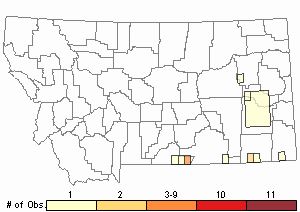
Recency
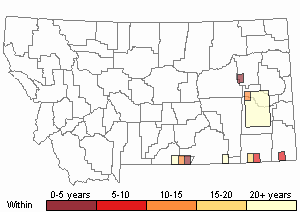
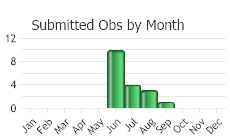
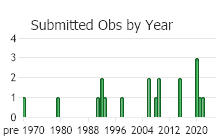
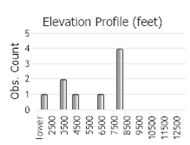 (Observations spanning multiple months or years are excluded from time charts)
(Observations spanning multiple months or years are excluded from time charts)
Habitat
Sparsely-vegetated soils of washes and steep, eroded gullies in dissected or badlands topography. Associated species include Juniperus scopulorum, Chrysothamnus nauseosus, Artemisia ludoviciana, Atriplex confertifolia and Elymus trachycaulis. In other areas, this species is listed as typically growing in rocky or stony soils. However, in our area the species has also been noted from fine-textured soils.
National Vegetation Classification System Groups Associated with this Species
Forest and Woodland
Low Elevation - Xeric Forest and Woodland
Shrubland
Arid - Saline Shrubland
Sparse and Barren
Sparse and Barren
Ecology
The effects, if any of the introduced Rhinocyllus weavil on this species are unknown. Additional information on this species' ecology and management in Montana are lacking at this time.
POLLINATORS The following animal species have been reported as pollinators of this plant species or its genus where their geographic ranges overlap:
Bombus vagans,
Bombus appositus,
Bombus auricomus,
Bombus bifarius,
Bombus borealis,
Bombus centralis,
Bombus fervidus,
Bombus flavifrons,
Bombus frigidus,
Bombus huntii,
Bombus mixtus,
Bombus nevadensis,
Bombus rufocinctus,
Bombus sylvicola,
Bombus ternarius,
Bombus terricola,
Bombus sitkensis,
Bombus occidentalis,
Bombus pensylvanicus,
Bombus bimaculatus,
Bombus griseocollis,
Bombus impatiens,
Bombus insularis,
Bombus suckleyi,
Bombus bohemicus, and
Bombus flavidus (Thorp et al. 1983, Mayer et al. 2000, Wilson et al. 2010, Colla and Dumesh 2010, Colla et al. 2011, Koch et al. 2012, Williams et al. 2014, Tripoldi and Szalanski 2015).
Stewardship Responsibility
Threats or Limiting Factors
STATE THREAT SCORE REASON
Reported threats to Montana's populations of Wyoming Thistle indicate impacts at one population due to chemical herbicide application (MTNHP Threat Assessment 2021). Wyoming Thistle has a stature similar to non-native thistle species, and it is occasionally targeted by chemical weed control applicators in error.
References
- Literature Cited AboveLegend:
 View Online Publication
View Online Publication Colla, S., L. Richardson, and P. Williams. 2011. Bumble bees of the eastern United States. Washington, DC: USDA Forest Service, Pollinator Partnership. 103 p.
Colla, S., L. Richardson, and P. Williams. 2011. Bumble bees of the eastern United States. Washington, DC: USDA Forest Service, Pollinator Partnership. 103 p. Colla, S.R. and S. Dumesh. 2010. The bumble bees of southern Ontario: notes on natural history and distribution. Journal of the Entomological Society of Ontario 141:39-68.
Colla, S.R. and S. Dumesh. 2010. The bumble bees of southern Ontario: notes on natural history and distribution. Journal of the Entomological Society of Ontario 141:39-68. Koch, J., J. Strange, and P. Williams. 2012. Bumble bees of the western United States. Washington, DC: USDA Forest Service, Pollinator Partnership. 143 p.
Koch, J., J. Strange, and P. Williams. 2012. Bumble bees of the western United States. Washington, DC: USDA Forest Service, Pollinator Partnership. 143 p. Mayer, D.F., E.R. Miliczky, B.F. Finnigan, and C.A. Johnson. 2000. The bee fauna (Hymenoptera: Apoidea) of southeastern Washington. Journal of the Entomological Society of British Columbia 97: 25-31.
Mayer, D.F., E.R. Miliczky, B.F. Finnigan, and C.A. Johnson. 2000. The bee fauna (Hymenoptera: Apoidea) of southeastern Washington. Journal of the Entomological Society of British Columbia 97: 25-31. MTNHP Threat Assessment. 2021. State Threat Score Assignment and Assessment of Reported Threats from 2006 to 2021 for State-listed Vascular Plants. Botany Program, Montana Natural Heritage Program, Helena, Montana.
MTNHP Threat Assessment. 2021. State Threat Score Assignment and Assessment of Reported Threats from 2006 to 2021 for State-listed Vascular Plants. Botany Program, Montana Natural Heritage Program, Helena, Montana. Thorp, R.W., D.S. Horning, and L.L. Dunning. 1983. Bumble bees and cuckoo bumble bees of California (Hymenoptera: Apidae). Bulletin of the California Insect Survey 23:1-79.
Thorp, R.W., D.S. Horning, and L.L. Dunning. 1983. Bumble bees and cuckoo bumble bees of California (Hymenoptera: Apidae). Bulletin of the California Insect Survey 23:1-79. Tripoldi, A.D. and A.L. Szalanski. 2015. The bumble bees (Hymenoptera: Apidae: Bombus) of Arkansas, fifty years later. Journal of Melittology 50: doi: http://dx.doi.org/10.17161/jom.v0i50.4834
Tripoldi, A.D. and A.L. Szalanski. 2015. The bumble bees (Hymenoptera: Apidae: Bombus) of Arkansas, fifty years later. Journal of Melittology 50: doi: http://dx.doi.org/10.17161/jom.v0i50.4834 Williams, P., R. Thorp, L. Richardson, and S. Colla. 2014. Bumble Bees of North America. Princeton, NJ: Princeton University Press. 208 p.
Williams, P., R. Thorp, L. Richardson, and S. Colla. 2014. Bumble Bees of North America. Princeton, NJ: Princeton University Press. 208 p. Wilson, J.S., L.E. Wilson, L.D. Loftis, and T. Griswold. 2010. The montane bee fauna of north central Washington, USA, with floral associations. Western North American Naturalist 70(2): 198-207.
Wilson, J.S., L.E. Wilson, L.D. Loftis, and T. Griswold. 2010. The montane bee fauna of north central Washington, USA, with floral associations. Western North American Naturalist 70(2): 198-207.
- Additional ReferencesLegend:
 View Online Publication
View Online Publication
Do you know of a citation we're missing? Lesica, P., M.T. Lavin, and P.F. Stickney. 2012. Manual of Montana Vascular Plants. Fort Worth, TX: BRIT Press. viii + 771 p.
Lesica, P., M.T. Lavin, and P.F. Stickney. 2012. Manual of Montana Vascular Plants. Fort Worth, TX: BRIT Press. viii + 771 p. Lesica, P., M.T. Lavin, and P.F. Stickney. 2022. Manual of Montana Vascular Plants, Second Edition. Fort Worth, TX: BRIT Press. viii + 779 p.
Lesica, P., M.T. Lavin, and P.F. Stickney. 2022. Manual of Montana Vascular Plants, Second Edition. Fort Worth, TX: BRIT Press. viii + 779 p.
- Web Search Engines for Articles on "Wyoming Thistle"





